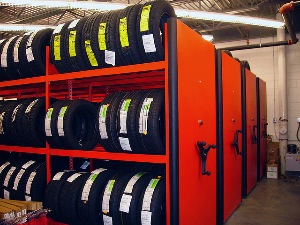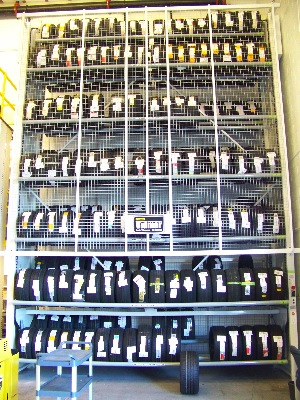To stack, or not to stack, that is the question.
Unfortunately, Shakespeare’s Hamlet, while contemplating his future existence, didn’t give tire dealers insight into storage systems to help them free up floor space or streamline inventory appraisals. Hamlet’s soliloquy completely ignored the fact that dealers could sleep and, perchance, dream, but still needed to get up the next morning, go to work and generate profits.
Perhaps the absence of great literary works that embrace the tire storage topic can be attributed to the simplicity of a dealer’s warehousing goals. Tires should take up as little floor space as possible, be easy to find and be safely stowed.
The tire storage goals don’t lend themselves to a riveting plot for a classic play, but they do generate great debates if ’tis nobler to store tires vertically, horizontally or laced. Before tire orientation is considered, however, a quick analysis should be completed to determine if your tire business is big enough to warrant an investment in a racking system.
According to Yannick Lejour, technical representative and account manager for Canada-based Martins Industries, an approximate threshold exists for the magnitude of tire inventory that merits an installation of some type of efficient storage matrix.
Martins has been designing and manufacturing tire storage, handling and display systems since 1987. Considered a world leader, it has plants in Montreal and Taipei, Taiwan, with distribution centers in Montreal, Atlanta, and Sydney, Australia.
“As soon as a tire dealer is storing more than 40 tires, racks become very useful,” says Lejour. “Organized storage helps to save room and provide easy access to all the tires in stock.”
Lejour says the most common way to store tires is on their sides, creating a barrel stack.
“Our passenger and light truck stacking rack is a versatile module that is quickly becoming our most popular system,” he says. “It can accommodate six to nine stacks of seven or eight tires, depending on the tires’ diameter, and averages 60 tires per rack. The racks can stack two high to maximize the use of floor and vertical space.”
He explains that it’s best if all tires in a rack have the same dimension to simplify finding and picking them, taking inventory and maintaining stability. It’s possible that government health and safety agencies may require that a rack be wrapped to prevent stacked tires from falling.
Laced tire storage – nestling one tire into the center of another – is the best way to conserve room, Lejour says. “Lacing maximizes the use of the open interior chamber of each tire and avoids using up to 40% of the space required to store tires on their sides or treads.”
Laced tire storage is normally utilized for large quantities of the same tire SKU, so a dealer’s employees don’t need to remove a lot of tires to gain access to a desired style and type.
Lejour says his company equips lacing racks with a wire mesh deck that allows employees to move safely around on them, while facilitating the flow of water through the storage unit in case of an emergency.
Storing tires on their treads is gaining popularity, according to Lejour. “Tires standing upright on a rack certainly make it easy to complete inventory checks and simplify finding and picking specific tires. An added benefit of storing tires on their treads is the ability to stow different sized units on the same rack.”
He notes that Martins’ new all-purpose light-truck and passenger folding rack – the MLTFD model – is ideal for storing tires on their treads, although it also can be used for laced tire storage. The racks are stackable to five high and equipped with steel plates that can protect stored tires if a forklift is used in the warehouse operation.
An added feature of the MLTFD is its ability to be folded down when not in use to save floor space during non-peak business periods. When closed, the rack consumes only 20% of its original storage volume and can be stacked 22 units high.
Other Options
If space is limited, three-, four- and five-tier shelf racks are available for storing tires on their treads, while a wall-mounted rack for small quantities of tires can be an economical solution. Lejour says a wall-mounted rack frees up all the floor space under it and can improve employee ergonomics.
He says his company views its products as ongoing contributors to a tire dealer’s lean operations.
“An appropriate rack system often enables a dealer to reduce handling, inventory and space requirements, so we often consult with our customers about integrated warehousing,” he says. “We can help determine the optimal rack configuration and aisle widths in order to store the maximum number of tires per square foot in a facility.”
Helping Design
Lejour adds that he enjoys helping dealers assess the storage needs of their specific operations.
He says he tends to recommend that smaller businesses use tire shelves, because they are perfect for a lesser number of tires – unmounted or mounted on rims. “Whether storing customers’ seasonal tires or new tires for retail sale, keeping them on their treads instead of stacking them saves stocking and retrieval time. Shelves are more useful in small areas and give dealers easy access in order to quickly find, unload or load tires.”
He explains that small operations with very limited floor space available are good candidates for wall-mounted shelves. “They can be placed at any height, giving the dealer the opportunity to optimize the work area.”
He recommends that larger operations consider using tire rack systems. “If seasonal swings in demand exist, modular tire racks that are designed to be transportable allow for safe storage up to five racks high with no need for an elevator system. Being able to fold them away allows quick and easy reorganizing of a warehouse.”
Lejour adds that he recommends stacking or lacing large quantities of tires, while smaller inventories and customer tires should be stored upright on their treads.
Safety is always at the forefront of tire storage system installations, he says.
Wall brackets are usually mounted at the top of tire racks to provide greater stability for unloading from the top tier. The same brackets can be used to attach one rack in front of another, while plate fasteners are used to attach them side-by-side to form a sturdy unit. Shelving should be anchored to the wall and floor. Shelving beams are usually constructed at an angle to properly seat tires and prevent them from falling over.
“Martins will work with a tire dealer’s health and safety team, government agencies, building insurer and local fire department to help integrate changes to a tire storage system,” says Lejour.
Yannick Lejour can be reached via e-mail at [email protected].













